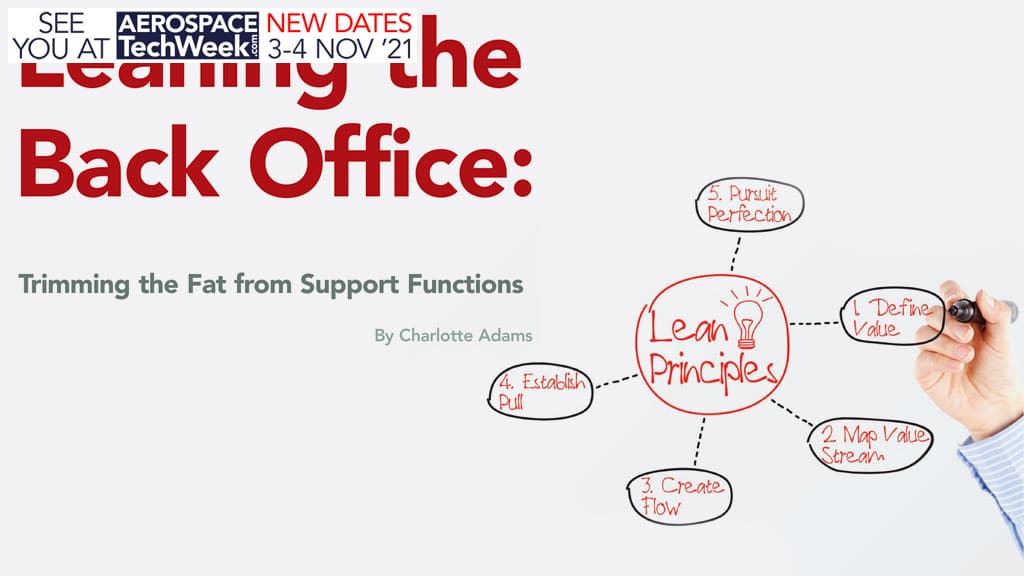In the highly competitive maintenance, repair, and overhaul market MROs are looking beyond the shop for efficiency gains. Among the successful navigators of this terrain are Fokker Aerotron (dba Aerotron Airpower), Aero-mark, Duncan Aviation, AAR, Southwest Technical Operations, and Lufthansa Technik. These companies have applied Lean optimization methods to processes involving functions such as engineering, scheduling, billing and purchasing.
Lean is an analytical process that goes to the root cause of a problem first, explains Bill Peterson, a lecturer at the business school of the University of Tennessee and a consultant specializing in the application of Lean to MRO business processes. (His clients include the U.S. Air Force, Southwest, Fokker Aerotron, and Aero-mark.) Lean can make a process flow more smoothly, increase business capacity, lower lead times, and reduce product prices, he says, affecting not just the support units but the core MRO mission.
Lean is “a huge deal” for AAR, says Dany Kleiman, group vice president for repair and engineering. Airframe maintenance is a tough business, so “if you don’t find a way every day to become more efficient and more effective, there is absolutely no way to survive and make any money.” He, along with everyone else who has embraced Lean, acknowledges that it isn’t easy. “It takes time to engage everybody in the work force,” he says. But “don’t give up,” he counsels. “There are a zillion opportunities to become better, but take the high trees first.”
Challenges
Lean can be a more challenging in the back office than on the shop floor, Peterson says. There’s less of a sense of urgency in the support units and the waste is less visible.
Ted Roethlisberger, the Lean leader at Duncan Aviation, however, points out that implementation in the second floor environment may be relatively easier. These employees aren’t shift workers, so a Lean team doesn’t have to get buy-in from multiple groups.
Peterson also suggests, from his experience, that the leading source of waste in MRO business processes is a lack of organizational focus – a category that he added to the Lean lexicon. This is not a problem on the shop floor because the mission is so obvious there. But in support offices – government or commercial – employees often lose track of the core mission and the core customer. It’s easy, as an organization grows, for support processes to become silos that optimize themselves at the expense of the whole, Peterson explains.
Another source of waste that may experts point to is overprocessing — putting too many steps into a process.
Once a process has been improved, the metric for its efficiency needs to be changed, Peterson adds. The unit whose process has been optimized may have sacrificed some of its output for the greater good, so its job performance measure needs to be recalibrated.
Many steps in a support process, moreover, are inside a computer or in thought processes, so waste is very hard to see. “You can see the machining of a part but not the thought processes going into a document,” Peterson says. He tries to make knowledge work “visual.”
There are also cultural issues. Sometimes people don’t ask “why” often enough, says Roethlisberger. People tend to identify the immediate cause of a problem but not the root cause. They apply a band-aid and move on. These additional, often unnecessary, steps may actually compound the problem.

You First, Back Office
Lean efforts often start on the shop floor. Then solutions to those constraints point to constraints elsewhere. But it doesn’t always work this way.
At Fokker Aerotron Lean began on the administrative side. The company is an independent component MRO (CMRO) in LaGrange, Ga., which repairs and overhauls aircraft accessories for the major airlines. Over the past seven years Fokker Aerotron has held 20 or more Lean events and continues to do so as business factors change and new constraints emerge.
While Fokker Aerotron didn’t have a “burning platform,” it was not meeting turn time or on-time delivery requirements that customers demanded, explains Stacey Karr, director of purchasing and materials and director of continuous improvement for the company. “Aerotron was looking for ways to improve our processes so we would have an edge over our competition.” The company has worked with Peterson to analyze its processes.
“I was very skeptical” at the first Lean training event, Karr says. She had seen the company try various methods of process improvement in the past without much success.
Not-in-stock (NIS) procedures were a major opportunity, she says. This “bucket” includes the processes of ordering a part, receiving it, and issuing it to the shop. When the team analyzed these processes, they found waste in simple things like filing and faxing hard copies of purchase orders when electronic versions existed, numerous approval processes, handoffs, flow issues, etc.
Lean projects initiated between 2008 and 2011 – covering the whole process from a technician’s request for a part to issuing the part to the shop so the technician could repair or overhaul the component – yielded dramatic results.
In 2008 average overall turnaround time (TAT), from start to finish, was close to 50 days, Karr says, whereas the CMRO industry strives for TAT of 14 days or less. TAT is now approximately 15 days, she says. There were 234 steps and 70 handoffs in 2008. These were decreased to 109 and 28, respectively, in the following two years.
All told the Lean remedies produced savings of $500,000 in one year with an investment cost of less than $5,000. On-time delivery rose from 28 percent to 88 percent over the period.
Southwest
Southwest Airlines’ Technical Operations unit also started Lean on the administrative side, says Yesso Tekerian, senior manager of engineering standards. Tech Ops has initiated about 100 Lean events in the last two years.
First the organization undertook an educational awareness program, he recalls. The Lean staff (two dedicated employees) developed “facilitation training.” At last count around 60 employees were trained as Lean/Six Sigma green belts, participating in projects on an as-needed basis. We also made sure people understood that we would promote the “Toyota or Honda way” of encouraging improvements, however small, and then coming back to revisit them, Tekerian says.
An engine asset management initiative – which blossomed into some five separate projects over the course of a year – addressed the administrative processes involved in the engine maintenance cycle, from the time an engine comes off wing, to when it arrives at Tech Ops in Dallas, to when it’s sent off to the GE engine shops, to its return to Dallas and being sent out as a spare. Ultimately Southwest was able to increase the throughput of the engine cycle by 22 percent, Tekerian says.
Another Tech Ops project involved engineering. “At the end of 2014 and into the beginning of 2015, we applied Lean principles to the engineering processes associated with the induction of previously operated airplanes,” explains Kent Horton, the carrier’s director of engineering. These aircraft have to be reconfigured — in areas such as paint schemes, interiors, and avionics — to meet the airline’s standards.
“We reduced the turn time for engineering conversion documentation by 35 percent and improved our structural repair review flow time by 32 percent…We are now at 62 percent, and climbing, for on time deliveries year to date in 2015.” – Kent Horton, Southwest
The problem was that the airplanes were coming out late. In 2014 none of the airplanes were considered to have been completed “on time” due to the inefficiencies and challenges with the various support processes, he says.
Lean methods, however, significantly improved overall performance. For example, the engineering department’s process of creating a statement of work for an airplane — near the front end of the process — has reached an efficient cadence. A statement of work is now generated every seven days, Horton says. This is important since the document is used by a lot of stakeholders in the project.
Overall throughput of airplanes placed into revenue service has increased from nine in 2014 to a projected total of 26 in 2015. Contributing to this increase were numerous improvements in engineering processes. “We reduced the turn time for engineering conversion documentation by 35 percent and improved our structural repair review flow time by 32 percent,” Horton says. “We are now at 62 percent, and climbing, for on time deliveries year to date in 2015.”
The induction project focused on things like lack of organizational focus, cadence, and work in progress (WIP) levels, he says. “The whole Lean mindset starts at the individual level, in terms of understanding WIP and the consequences of having too much of it,” Horton says.
Some of the changes involved focusing on when various documents are needed by the production floor and moving people closer together in order to reduce communications delays.
Paperwork
Too much paper or too many steps can be signs of inefficient processes. At AMRO, a CMRO unit of the aerospace holding company, Aero-mark, Peterson helped to slim down the document package that records all work on an aircraft part from seven pages to a single page. Leaning the work pack involved eliminating a lot of waste, such as repeated stapling and unstapling steps, recalls Brad Caban, president of Aero-mark.
A side benefit of the process improvements has been an improvement in quality, Caban notes. Repairs for units under warranty have gone down to less than 1 percent at AMRO, he says. AMRO also has set up an internal “warranty tracker” process which flags “repeat offenders” — units that have been to the facility in the last 24 months. These flags alert everyone to take a closer look at the unit, which may have an intermittent fault or be a rogue part. We’re able to spot some problems before our airline customers see them, he says.
An event at CAS (Certified Aviation Services), Aero-mark’s “touch maintenance” unit, involved days sales outstanding, or DSO, a measure of the time from performing a repair to receiving payment for it. This was shortened by 12 days through eliminating waste in invoice processing and other procedures, Caban says. (CAS does line maintenance and modification work for airlines at airports around the country.)
One of the improvements at CAS involved the creation of standard contract checklists for mechanic, quality assurance, and billing processes. The checklists were designed to get rid of chokepoints in the process where things slowed down while an employee was waiting for other inputs. As a result of applying Lean and developing a solution, everybody understood what the optimum process flow is, so that a lot of waiting was eliminated. We didn’t really change our work orders, but we managed them more efficiently, Caban says.
“We also went to preprinted forms wherever we could,” he says, to make inputs easier and to make sure all the proper forms have been filed. A software “dashboard” tool was also acquired for CAS billing analysts, so they would know which jobs needed attention.
Lean Pull Events
One engineering project at Duncan Aviation back in 2013 emanated from the shop floor, Roethlisberger recalls. At the request of the cabinet shop, a Lean team with members from engineering and the shop came up with a way to do drawings that allowed the shop to create and assemble cabinetry more efficiently. “There was no problem with the drawings,” he says. “It was just that the way they were drawn required more jigs to be built by the production shop.”
It turned out that the engineering department had optimized its processes in a way that was repeatable and efficient for the department but that was less efficient for the shop. The solution was for the engineering department to provide data that allowed the cabinets to be built in a more timely manner.
The solution produced an 81 percent time saving in the shop, but added five minutes to the drawing process for each panel. That drawing time has further decreased as the engineers have further optimized their process.
The engineering project is an example of a “pull event,” in which ideas for improvement bubble up from the shop floor, Roethlisberger says. That is how we try to do Lean, he says.
Lufthansa Technik
Lufthansa Technik has also applied Lean to its business processes. When it started with Lean about 10 years ago, the MRO focused on the shop floor. It held back for “quite a while” from applying Lean to business processes, says Christian Langer, vice president of corporate improvement projects. The reason was that optimizing administrative processes can lead to direct reductions in the number of full-time positions in a company vs. improvements on the shop floor that can directly contribute to support business growth, he explains.
In Lufthansa Technik’s case there have been reductions in the number of employees in business processes, but separations from the company were voluntary, and many occurred through early retirements and natural attrition. Other employees stayed with the company but moved to new job assignments.
Dr. Christian Langer Takes on New Role Lufthansa Technik Logistik

Dr. Christian Langer has been appointed as managing director of Lufthansa Technik Logistik Services (LTLS) starting September 1, 2015. He takes over this role from Andreas Meisel, who moved from this position after more than four years to join Ameco Beijing as chief MRO operation officer of the Executive Management.
Dr. Langer has been employed at Lufthansa Technik since 2004. He started his career in product management for aircraft maintenance in Frankfurt. He has been responsible for developing the lean production system and the Lufthansa Technik Lean Academy since 2007. In 2012 he additionally took on responsibility for a restructuring project of the administrative body of Lufthansa Technik and in 2013 became the founding managing director of Lumics GmbH & Co. KG, a joint venture between Lufthansa Technik AG and McKinsey & Company.
Dr. Langer studied Computer Science at the University of Koblenz. Following his degree and position in management consulting, he obtained a PhD (Dr. rer. pol.) from the WHU – Otto Beisheim School of Management in Koblenz.
“The first thing a Lean team looks at … is how to reduce variation in customer needs as much as possible. They look for patterns in needs, for example, so work can be done more efficiently. The second question is how to increase the flexibility of the work force. But variety can’t be reduced to zero and flexibility can’t be increased to 100 percent. So the third question becomes how to reduce the remaining waste.“ – Dr. Christian Langer, Lufthansa Technik
LHT began applying Lean to “hardcore” administrative processes about five years ago. This involved departments such as accounting and engineering and processes such as maintenance scheduling.
Maintenance scheduling was chosen because changing business conditions identified a constraint there. Lower-cost carriers have different maintenance patterns from those of the legacy carrier, Langer explains. New airline customers also have different needs.
One of the results of the project was to make the maintenance scheduling process more responsive to different customers’ needs, explains Johannes Weidisch, LHT’s director of Lean management. The project succeeded in scheduling maintenance more efficiently, so that Lufthansa, for example, has increased the utilization of aircraft in revenue flights by the “low double-digit” numbers per month, Langer says.
The first thing a Lean team looks at – both on the shop floor and in administrative processes — is how to reduce variation in customer needs as much as possible, Langer says. They look for patterns in needs, for example, so work can be done more efficiently. The second question is how to increase the flexibility of the work force. But variety can’t be reduced to zero and flexibility can’t be increased to 100 percent. So the third question becomes how to reduce the remaining waste.
In the area of core financial processes Lean projects aimed for about a 15 percent increase in efficiency Weidisch says. Responsibility for purchasing, for example, has been centralized in one department rather than being distributed through different business units. Undertaken last year, the project has reduced the number of purchasing positions by a third with a more standard approach.
The MRO unit has been so successful with Lean on the shop floor and in the back offices that it is contributing its expertise to other industries via Lumics, a 50/50 joint venture with the McKinsey consulting firm. So far customers of the two-year-old Lumics organization have included not only airlines and aviation OEMs but also companies in the chemical and oil and gas industries, which have similar maintenance-intense processes and safety concerns.
AAR: Software Tools
Software tools are often employed to support Lean process improvements. This is especially true in the case of AAR, whose StAAR (Strategic Tools by AAR) work flow management software has been enhanced to help implement process changes, driving improvements in cost recovery and cash flow.
AAR has Lean teams at practically every facility, Kleiman says, and these teams are coordinated and harmonized at the group level to share best practices and move resources to where they are needed. The overall goal is to provide a uniform level of service or what the company calls “one MRO.”
The company has held “value stream mapping events” to optimize the management of processes such as contracting, communications with customers, billing, and negotiating with customers, Kleiman says.
Aspects of the billing cycle have improved dramatically, thanks to Lean. And customers participated in the Lean team that developed the improvements. Among the optimizations that resulted from their analysis are customer approvals or rejections of requests for expansions of the scope of work or labor hours within 24 hours. The process improvements were supported by the development of an electronic log, which is linked to the StAAR system. This allows customers to approve or reject requests on-line via their iPads or iPhones. AM
